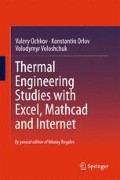Abstract
This chapter describes the methods of calculation of grids—hydraulic and electric. Emphasis on the mathematical basis of solving such problems. Described methods of improving the efficiency of power supply due to the simultaneous production of heat, electricity and cold.
Energy efficiency in Russia is air inlet to the conditioned room which is in its turn overheated by radiator.
The site of the chapter: https://www.ptcusercommunity.com/message/422965.
Access this chapter
Tax calculation will be finalised at checkout
Purchases are for personal use only
Notes
- 1.
Mathematician’s comment. Not every problem in which the number of equations is greater than the number of unknowns, is overdetermined. For example, if the equations are linearly dependent, the described system can be defined (in fact this is shown in an example of calculation), and uncertain. The ratio of the number of equations and the number of unknowns is not a criterion of overdetermination. Probably, you should not generally pay as much attention to this delicate issue. It might be better to say that anything can happen with the systems, but the package itself can (or cannot!) figure it out.
- 2.
Mathematician’s comment. If the problem is overdetermined, then why add another equation? Or why they cannot be added if they are physically necessary? Something should be justified. Probably, to refer to the theory of calculating circuits, or to something else. In any case, before considering the numerical solution of the system one should substantiate the adequacy of a chosen mathematical model (having the form of a system of linear algebraic equations) of a studied physical model of electrical circuit.
- 3.
Mathematician’s comment. Why is that? Is it always? Which system? Who or what is required to specify them in this case? We need to know the specifics of the numerical method, hardwired into the package.
- 4.
Mathematician’s comment. Why are they superfluous, why these are superfluous and not others? From the point of view of the theory of systems of linear algebraic equations, the extra equations are found, and not in the only way, only after finding the rank of the augmented matrix. Here it is probably more appropriate, without going into the mathematical details, to provide physical or technical justification for allocating extra equations.
- 5.
Mathematician’s comment-question. And you cannot get it? How is it determined?
- 6.
Mathematician’s comment-question. What does it mean “similar”? If the solution is unique and approximative (numerically) coincides with the desired, then for the technical calculation this is not a nuisance, but the norm. If the mathematical theory proves the absence of a solution, which is yet present (i.e. calculated), or the existence of an infinite number of solutions (unknowns are more in number than the rank of the system), but only one is calculated, it means that the used model is incorrect. And this is a very big trouble.
- 7.
The problem of the dynamics of motion of a body in a viscous medium, we consider in the next chapter.
- 8.
Engineers have to solve not purely technical but technical and economic problems.
- 9.
Present-day continuation of this “joke with the beard” is below. People on the balloon shout in response that the batteries got low in their navigator. The man on the ground looks at his smartphone with navigation and shouts back, “You are at the point of 0.9677 rad north latitude and 0.646 rad east longitude. Only mathematicians measure angles in radians, not degrees.
- 10.
Caution! The computer can be pushed to the wrong decision.
- 11.
Author information
Authors and Affiliations
Corresponding author
Editor information
Editors and Affiliations
Rights and permissions
Copyright information
© 2016 Springer International Publishing Switzerland
About this chapter
Cite this chapter
Ochkov, V. (2016). Cogeneration (CHP), Trigeneration (CCHP) and Quadrogeneration (CCHPI), or How Much of Mathematics Is Contained in Thermal Engineering. In: Rogalev, N. (eds) Thermal Engineering Studies with Excel, Mathcad and Internet. Springer, Cham. https://doi.org/10.1007/978-3-319-26674-9_17
Download citation
DOI: https://doi.org/10.1007/978-3-319-26674-9_17
Published:
Publisher Name: Springer, Cham
Print ISBN: 978-3-319-26673-2
Online ISBN: 978-3-319-26674-9
eBook Packages: EngineeringEngineering (R0)

